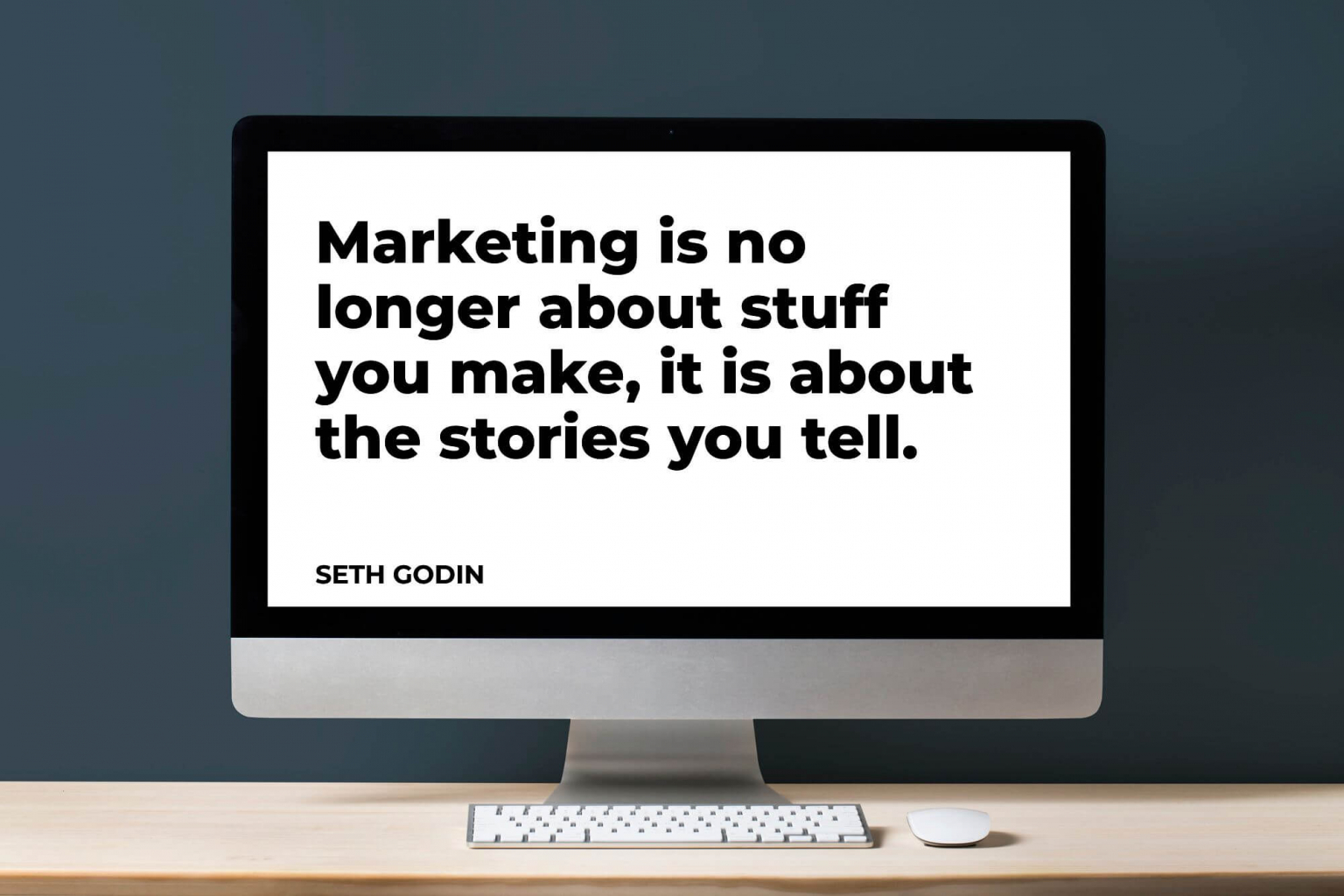To elevate your business or your clients’ business you must craft compelling stories that require vision, creativity, skill and practice, and that means mastering the sophisticated art of business storytelling.
What Is Business Storytelling?

Business storytelling can be a powerful technique and a proven framework when it comes to getting your clients or investors immersed immediately or, generally, getting people to say “yes.”
Every business has a story to tell. However, grandiose ideas and visions for your products or services are not enough. In today’s fast-moving digitally-driven world, brands and businesses cannot afford to lack humanity. Hence, it is a must to connect with your audience and engage with them on a deeper level through your content. This is where business storytelling comes in.
“Storytelling is the game. It’s what we all do. It’s why Nike is Nike, it’s why Apple is Apple, it’s why Disney built Disney World and it’s why Vince McMahon makes a billion dollars.”
– Gary Vee
If you think about it, the most successful companies and businesses have the skill to weave their narratives and develop profound stories behind their brands – the stories that foster and implant a feeling of greater value and higher purpose.
Let’s take a look at Airbnb, for instance. Not only has Airbnb been connecting with their target audience, but it has additionally been connecting their audience (travelling guests) with lodging hosts, thus creating a network of even 2 different target audiences. In a nutshell, Airbnb’s story is based on connecting people. It uses community storytelling to build its business and a global brand. Just scroll through the Airbnb social media feed and you will find yourself immediately captivated by the stories of travellers, guests, hosts and all the people from around the world that share and represent Airbnb values. In the case of Airbnb, the business storytelling paid off. In 2018, Forbes valued Airbnb at $38billion.
A Formula For Successful Business Storytelling

So, in order to share your story, you need to capture your clients’ attention first and convey the purpose of your business. The narrative you communicate with your audience will position your brand, your vision and your values. Your story should be the backbone around which your entire content marketing strategy is built. Your business storytelling is to be treated as the blueprint for the business. To maximise your business’s visibility (and, eventually, profit), you should invest in developing a precisely communicating story that will act as the compass for your marketing strategy, which includes clear, effective and compelling marketing communication.
Although new forms of narrative appeared as new mediums emerged, the universal truth has never changed: stories are meant to foster emotional connection among people. According to a Harvard Business Review study, emotional connection is crucial for building brand loyalty and one of the best indicators of future customer value. What is more, the majority of customers are more likely to recommend the brands with whom they have created an emotional bond.
All you need to do is provide your customers with a story that will help them connect with your brand on a deeper level, buy your products or services, or even turn them into your brand advocates. If you can trigger emotional responses through all 6 senses in your story scenes, and transform the dry facts by bringing them to life and reframing them as human experience, you will drive your narrative toward the desired point – the selling point. In a less intrusive way business storytelling becomes a much more powerful form of product advertising than a series of facts and merely advising consumers to buy a product. When customers buy Nike or iPhones, it is not just to have such amazing products, but to be part of their stories and enjoy the benefits they get from joining the brand universe.
Digital marketing is all about getting people’s attention, which has been super hard these days. Digital marketing experts estimate that the average consumer is exposed to more than 5,000 advertisements daily, and most of them get ignored. When building a story for your business, it is important to build a framework to clarify your message so your customer will listen. So, if you want to draw attention to your business, you need to master a powerful formula that has been grabbing and keeping people’s attention for thousands of years: invite customers into your story.
3 Memorable Business Storytelling Examples
Every memorable story is built on a simple framework. The story has a hero, and the hero of your business story should be your customer. That is the only way to engage your customers and invite them into your story. Your brand is just their guide that helps them navigate through and overcome challenges to their success. Your brand should offer them a vision of a better life, shaping their future towards a happy ending.
IKEA
One of the best examples for inviting customers into the story is IKEA, a Swedish furniture retailer that wins the hearts of consumers from all over the world. IKEA invites buyers to have a trip to their stores, specially designed to make the shopping experience enjoyable. The mesmerising maze of aesthetic, yet affordable products has a one-direction path labelled on the floor which has been created in a way that it does not let you leave the store before you have seen all the displayed products.
In case the customers get hungry, the famous Swedish Meatballs are there to enrich their shopping experience so they are not left with empty stomachs. They thought about everything, didn’t they? The shopping experience continues even when the customers get home and start assembling the products from the packages on their own. To get to the point, customers are always at the epicentre of their business storytelling, and the products are just a part of those stories of each and every customer individually.
Apple

Apple came up with another way of inviting people into their stories by focusing completely on the customers’ needs and desires. This tech giant turned the stores into the destinations for its customers. However, they are far more than just uncluttered minimalist store design and the slickest gadgets on the shelves. Apple reshaped the way the stores work by turning them into “town squares” with the “playground” vibe – places specially designed to provide and deliver something new, cool and exciting for the customers. People are invited to touch the products, to interact with them, to test drive them, and let’s not forget that touch is a powerful sense. Once we touch something, we connect with it in a way.
If you are wondering what the Apple store is really about, the answer is people, and Apple’s ultimate goal is “enriching lives” – an idea conceived by Steve Jobs himself. Their business storytelling is based on creating an Apple experience and building strong customer relationships. Sales assistants assist: they lead customers with warm professionalism, give them useful advice – no matter if it does not lead to a direct sale. The Apple staff are trained to follow a series of steps when providing the “customer service”, which is summarised in the acronym APPLE – the method pioneered by the Ritz-Carlton luxury hotel chain.
A: Approach customers with a personalised, warm welcome
P: Probe politely to understand the customer’s needs
P: Present a solution for the customer to take home today
L: Listen for and resolve issues or concerns
E: End with a fond farewell and an invitation to return
Simple, isn’t it? Yet, very effective. With its state-of-art customer experience Apple wins over customers worldwide differentiating from the competition and making the customers come back again and again.
Coca Cola
Another amazing example of how to invite your audience into your story is a lesson we can learn from Coca Cola. By inviting us to “Taste the Feeling” in the holiday ads with Santa Clause, Cola marketing experts have managed to develop a close association between their products and the festive figure, both reflecting joy and happiness, thus making us conjure up pleasant holiday memories and remember what really feels good.
All the Santa and Christmas images in our heads and the stories we have ever heard come together into one story when we see, smell and taste this refreshing soft drink. The more we associate Coca Cola with Santa (and holidays), the more similar perception of the brand we create, which is known as the halo effect. Conveying the heartwarming story of the brand Cola arouses an emotional response in the target audience creating mutual understanding and irresistible customer experience.
The Process Of Building A Business Story

So, what would be a quick test to check if your business is on the right track? Check your website’s home page. Is your story about the customers? Is your message clearly crafted and are your media channels updated? Your marketing should invite your current and potential customers into your story. If the answer is no, then you are probably losing your money.
Now when we established that business storytelling should be an essential part of your content marketing strategy, we can move on to how the process of building a story should look.
If you have just started a business or if you are about to launch one, you will need to read a lot of material about the perfect pitch for your business, which must include a compelling story. To determine your “why”, which is practically the first step of building your business story, ask yourself these questions:
- Who is my audience?
- What message do I want to convey?
This is the moment when your story starts to flow.
The Elements Of Remarkable Business Storytelling

To be an exceptional storyteller, you must be able to speak a universal language that everybody can understand, regardless of nationality, cultural heritage or dialect. You need to be capable of crafting stories strategically, with intent and purpose. Use carefully chosen words, draw your listeners’ attention, trigger their imagination, spark excitement and stir their emotion.
When it comes to successful storytelling in business there are some principles that should be followed. Regardless of the medium, whether it is face-to-face speaking, public speaking, copywriting, or business storytelling, excellent stories have certain elements in common.
Know Your Audience
Have you ever done your audience research? Do you know everything about your target persona? If the answers to both questions are no, then you should definitely do target market analysis that will help your story resonate with them.
Include Relatable Characters Into Your Story

Understanding your audience, their challenges and their aspirations, is the key. Include the characters that your audience can relate to personally, or at least recognize in them someone who is like them. Of course, if you make your audience the hero of your story, and thus part of the story, that would be the best option. When selecting the character of your story, you must think about if this character is the best fit for your brand. Ask yourself these questions:
- Who or what best illustrates the values of my brand/ business?
- Am I (the founder) or an employee a better choice to represent the brand?
- Can I use customers to promote my brand?
- Do I need a public representative of my brand?
Observe how beauty brands choose their characters. For instance, Dove uses real customers and their experience in order to increase authenticity, thus making the story more relatable to the audience. After you have selected the character, use it to move the narrative forward.
Include A Conflict
There is no story if there is no conflict. This conflict will be a hook that will grab your audience’s attention. To put it simply, the conflict is the presentation of a problem that you provide a solution for. Consider the fears and challenges your customers are facing. Think about what troubles them and how your business can help them overcome those challenges. Include believable obstacles and struggles that your audience can identify with and have a feeling as if they were their own obstacles. If your story has a good conflict, your audience will want to know what happens next and be part of the quest. Otherwise, they will lose interest and stop investing their time.
Include Resolution
If there is conflict, there has to be a solution, and that is something your business provides – a compass to guide your target audience solve their problem.
Define Your Core Message
Develop your story towards the key idea and the point. Your story must revolve around the message you want to share with the audience. Define your “WHY”. Your audience needs the reason why they should continually pay attention to the story. The core message is the point to the story, the lesson they learn and apply in the future. If your story fails to share a great lesson or purpose, you might lose your audience.
Be Authentic

Authenticity is very important if you want to engage with your audience in a meaningful way. Don’t try to fool your audience with over-the-top stories if you want to win their trust. Your target audience must have the sense that the story you are telling is original, genuine and real. Authenticity and honesty help your brand better connect with your audience.
One such brand that radiates authenticity is Aura – an online platform that provides a digital space for emotional support for people who need assistance towards the end of their life. The idea behind the brand came from a personal need of a man who was diagnosed with a terminal illness. Instead of giving up, Paul Jameson, the founder of Aura, was inspired to open up conversation, bring families together and help people feed less alone. He reached out to our agency and Eton Digital team breathed life into Paul’s insightful vision and turned it into reality creating a platform that makes difference and that has helped more than 100,000 people tackle their anxiety and plan ahead for the inevitable.
Establish Call-To-Action
If your narrative is the one that gets your audience hooked, but if it lacks call to action, then your audience won’t know what to do next. Hence, there won’t be any sales or conversions. Invite your audience for a small commitment, such as joining your subscriber’s list so you can tell them more stories, build the relationship and eventually convert them into your customers.
Practice Makes It Perfect
It takes more than just a talent to tell compelling stories. The more stories you tell, the better you become at storytelling.
Consult Marketing Experts
If you want to maximise your business valuation, don’t waste time trying to figure everything out on your own. Speed up the process with digital business consulting. Consulting marketing experts can help you save precious time and money, as well as create new business opportunities.
Final Thoughts

The brand that exists through the story is closer to its target audience because it lives within a pattern that they understand instinctively. The greatest value of business storytelling is emotion. A good story is the one that hypnotises you, moves you, inspires you or makes you change your opinion. Business storytelling creates the most important thing – an emotional connection with the brand in the long term. Finally, that inspires action and leads to conversion.
Here at Eton Digital, we are experts on integrated marketing. Our purpose is to help you design unique brand stories which develop close and long lasting relationships with your customers. We are passionate about creating content marketing strategies and establishing consistent communication across different platforms to earn your customers’ trust. We are always excited to help brands and businesses deliver the whole package of content marketing services and improve user experience.
If you need help with marketing, conversion rate, or crafting effective brand storytelling strategy, our agency offers the services tailored to your needs that will help you convert and grow.




